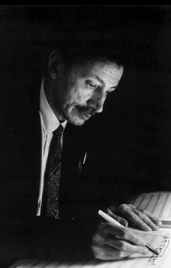Alan Hovhaness
Friday, March 7, 2025
Alan Hovhaness (March 8, 1911 – June 21, 2000) was an American composer. He was one of the most prolific 20th-century composers, with his official catalog comprising 67 numbered symphonies (surviving manuscripts indicate over 70) and 434 opus numbers. The true tally is well over 500 surviving works, since many opus numbers comprise two or more distinct works.
The Boston Globe music critic Richard Buell wrote: "Although he has been stereotyped as a self-consciously Armenian composer (rather as Ernest Bloch is seen as a Jewish composer), his output assimilates the music of many cultures. What may be most American about all of it is the way it turns its materials into a kind of exoticism. The atmosphere is hushed, reverential, mystical, nostalgic."
He was born as Alan Vaness Chakmakjian (Armenian: Ալան Հարությունի Չաքմաքչյան) in Somerville, Massachusetts, to Haroutioun Hovanes Chakmakjian (an Armenian chemistry professor at Tufts College who had been born in Adana, Turkey) and Madeleine Scott (an American of Scottish descent who had graduated from Wellesley College). When he was five, his family moved from Somerville to Arlington, Massachusetts. A Hovhaness family neighbor said his mother had insisted on moving from Somerville because of discrimination against Armenians there. After her death (on October 3, 1930), he began to use the surname "Hovaness" in honor of his paternal grandfather, and changed it to "Hovhaness" around 1944. He stated the name change from the original Chakmakjian reflected the desire to simplify his name because "nobody ever pronounced it right". However, Hovhaness' daughter Jean Nandi has written in her book Unconventional Wisdom, "My father's name at the time of my birth was 'Hovaness', pronounced with accent on the first syllable. His original name was 'Chakmakjian', but in the 1930s he wanted to get rid of the Armenian connection and so changed his name to an Americanized version of his middle name. Some years later, deciding to re-establish his Armenian ties, he changed the spelling to 'Hovhaness', accent on the second syllable; this was the name by which he later became quite famous."
Hovhaness was interested in music from a very early age. At the age of four, he wrote his first composition, a cantata in the early Italian style inspired by a song of Franz Schubert. His family was concerned about his late-night composing and about the financial future he could possibly have as an artist. He decided for a short time to pursue astronomy, another of his early loves. The fascination of astronomy remained with him through his entire life and composing career, with many works titled after various planets and stars.
Hovhaness's parents soon supported their son's precocious composing, and set up his first piano lessons with a neighborhood teacher. Hovhaness continued his piano studies with Adelaide Proctor and then Heinrich Gebhard. By age 14 he decided to devote himself to composition. Among his early musical experiences were Baptist hymns and recordings of Gomidas Vartabed, an eminent Armenian composer. He composed two operas during his teenage years which were performed at Arlington High School, and composer Roger Sessions took an interest in his music during this time. Following his graduation from high school in 1929, he studied with Leo Rich Lewis at Tufts and then under Frederick Converse at the New England Conservatory of Music. In 1932, he won the Conservatory's Samuel Endicott prize for composition with his Sunset Symphony (elsewhere entitled Sunset Saga).
In July 1934, Hovhaness traveled with his first wife, Martha Mott Davis, to Finland to meet Jean Sibelius, whose music he had greatly admired since childhood. The two continued to correspond for the next twenty years. In 1935, Hovhaness named his daughter and only child from his first marriage Jean Christina Hovhaness after Jean Christian Sibelius, her godfather and Hovhaness's friend for three decades.
In 1936, Hovhaness attended a performance in Boston by the Indian dance troupe of Uday Shankar (with orchestra led by Vishnudas Shirali), which inspired his lifelong interest in the music of India. During the 1930s (until 1939), he worked in Franklin D. Roosevelt's Federal Music Project.





